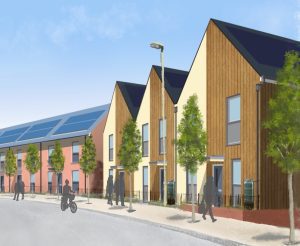
As well environmental reporting for social landlords we also work in other sectors. Here’s an example where one of our Stroud-based office colleagues, Caroline, wanted advice on transforming her house to an ecohome.
This was very much a pilot to see if we could create a local service which strikes the right balance between robust advice to the client whilst minimizing the cost. Here’s what we did.
Desk based research
We checked the national energy efficiency database for any lodged EPC’s for Caroline address. In this case there were none, so we downloaded the EPC for a similar neighbour’s home as a proxy. This gave us a start on what features to look for and what interventions could possibly bring the house to an EPC C – the emerging all important pathway target towards net zero for homes.
We also checked the national flood risk database for flood risk.
House call
Our house visit confirmed, or otherwise, what features of the EPC were present, relevant and remained as a possible intervention to improve the home.
We also checked the flow rates and capacities of water fittings to see what scope there was to make improvements to hit looming water efficiency targets.
Normally we’d have a look at the garden to look at features which promote wildlife. As it was dark at the time of the visit, a simple chat clarified a few things.
Opportunities for sustainable transport were also investigated.
Written report
From a combination of desk based research and the house call we put together a clear and comprehensive roadmap on the things necessary to transform her home to an ecohome. It covered:
- Energy efficiency – to maximise co-ordination with reduced bills, increased comfort, low carbon emissions and national net zero pathways
- Water efficiency – some quick easy wins which align with national targets and save money in the home – one of the tips costs nothing to acquire and install
- Flood risk – it was fine on this occasion, but worth keeping an eye out in case national flood mapping changed
- Overheating risk – using a risk factors approach see how the house would deal with forthcoming heatwaves
- Waste – simple interventions to encourage more recycling (but Caroline is good at this anyway)
- Sustainable transport – what can be implemented to ensure alignment with national net zero transport policies
- Biodiversity – a little list of things to help create a wildlife friendly garden
What did Caroline think?
“A great, practical report that really made it clear on what I need to do next. I’ve already installed that water saving fitting that I got for free (great tip). I’m a great environmental activist and this roadmap for my own house is a great help.” Caroline Aistrop, Creative Director, Green Spark Marketing [1]
What next?
We’re hoping to develop this into a service we can spread out more widely throughout Stroud and surrounding area. We’re particularly interested to hear from builders / trades who would like to prepare for the coming boom in eco-retrofit.
All of what we did for Caroline is written up in chapters 5 & 6 of our MD’s book “Happiness by numbers”. The book is about the science of wellbeing measurement and how to include environmental protection in a science based way. Here’s a blog about the book: https://shiftenvironment.co.uk/news/happiness-by-numbers-how-to-measure-and-manage-your-wellbeing-to-make-a-positive-impact-on-the-world/
Feel free to get in touch if you want more information on this or any other environmental reporting topics.
